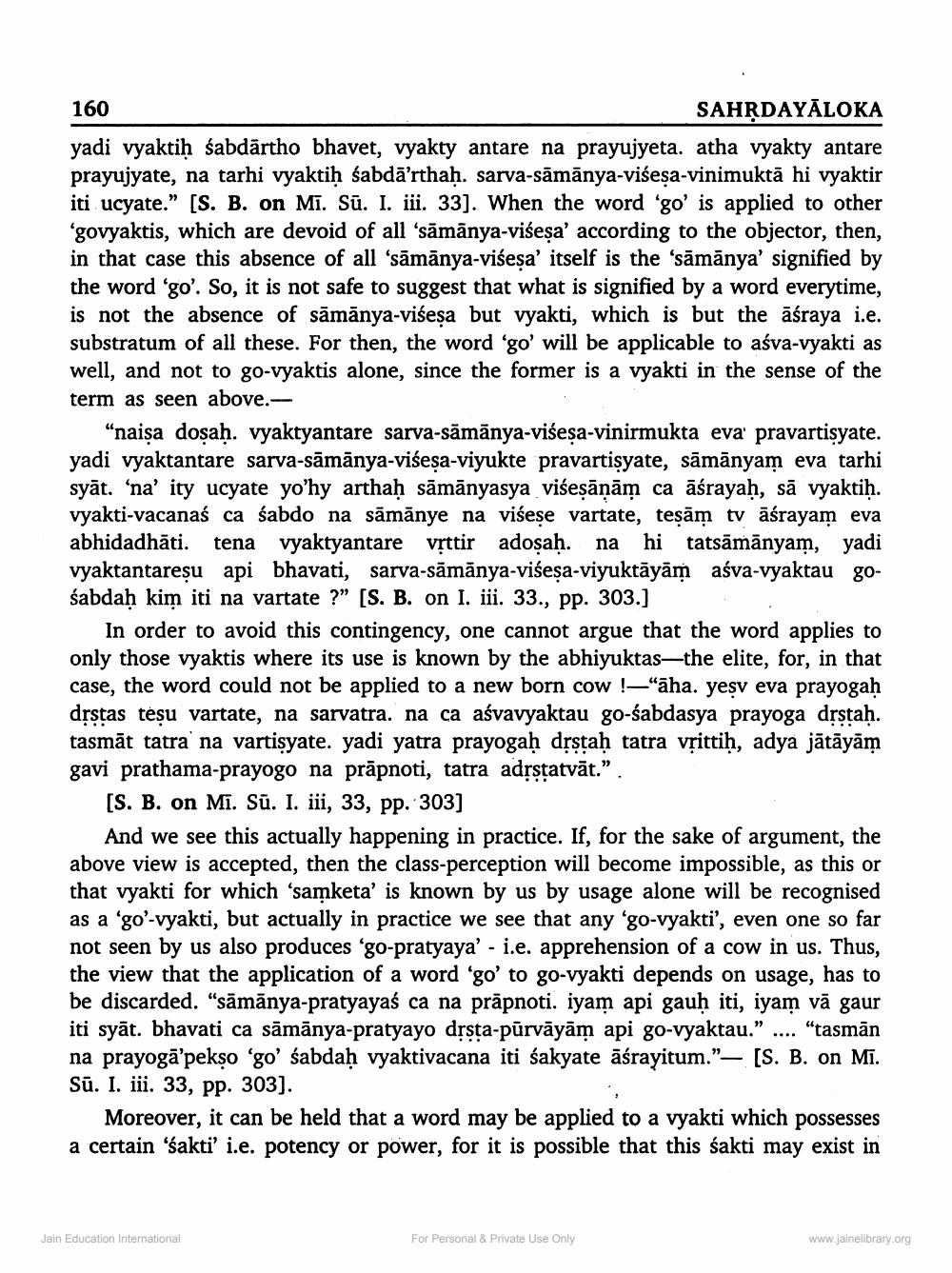________________
160
SAHṚDAYALOKA
yadi vyaktiḥ śabdartho bhavet, vyakty antare na prayujyeta. atha vyakty antare prayujyate, na tarhi vyaktiḥ śabdā'rthaḥ. sarva-sāmānya-viśeṣa-vinimuktā hi vyaktir iti ucyate." [S. B. on Mĩ. Sū. I. iii. 33]. When the word 'go' is applied to other 'govyaktis, which are devoid of all 'sāmānya-viseṣa' according to the objector, then, in that case this absence of all 'sāmānya-viśeṣa' itself is the 'sāmānya' signified by the word 'go'. So, it is not safe to suggest that what is signified by a word everytime, is not the absence of sāmānya-viśeṣa but vyakti, which is but the aśraya i.e. substratum of all these. For then, the word 'go' will be applicable to aśva-vyakti as well, and not to go-vyaktis alone, since the former is a vyakti in the sense of the term as seen above.
"naisa doṣaḥ. vyaktyantare sarva-sāmānya-viśeṣa-vinirmukta eva pravartisyate. yadi vyaktantare sarva-sāmānya-viseṣa-viyukte pravartiṣyate, sāmānyam eva tarhi syāt. 'na' ity ucyate yo'hy arthaḥ sāmānyasya viśeṣāṇām ca āśrayaḥ, sā vyaktiḥ. vyakti-vacanaś ca śabdo na sāmānye na viseṣe vartate, teṣām tv āśrayam eva abhidadhāti. tena vyaktyantare vṛttir adoṣaḥ. na hi tatsāmānyam, yadi vyaktantareṣu api bhavati, sarva-sāmānya-viseṣa-viyuktāyām aśva-vyaktau gośabdaḥ kim iti na vartate ?" [S. B. on I. iii. 33., pp. 303.]
In order to avoid this contingency, one cannot argue that the word applies to only those vyaktis where its use is known by the abhiyuktas-the elite, for, in that case, the word could not be applied to a new born cow!-"aha. yesv eva prayogah drstas teṣu vartate, na sarvatra. na ca aśvavyaktau go-śabdasya prayoga drstah. tasmāt tatra na vartiṣyate. yadi yatra prayogaḥ drstaḥ tatra vṛittiḥ, adya jātāyām gavi prathama-prayogo na prāpnoti, tatra adṛṣṭatvāt.".
[S. B. on Mi. Sū. I. iii, 33, pp. 303]
And we see this actually happening in practice. If, for the sake of argument, the above view is accepted, then the class-perception will become impossible, as this or that vyakti for which 'samketa' is known by us by usage alone will be recognised as a 'go'-vyakti, but actually in practice we see that any 'go-vyakti', even one so far not seen by us also produces 'go-pratyaya' - i.e. apprehension of a cow in us. Thus, the view that the application of a word 'go' to go-vyakti depends on usage, has to be discarded. "sāmānya-pratyayaś ca na prāpnoti. iyam api gauḥ iti, iyam vā gaur iti syāt. bhavati ca sāmānya-pratyayo dṛṣṭa-pūrvāyām api go-vyaktau." "tasmān na prayoga'pekso 'go' sabdaḥ vyaktivacana iti śakyate āśrayitum."— [S. B. on Mi. Sū. I. iii. 33, pp. 303].
Moreover, it can be held that a word may be applied to a vyakti which possesses a certain 'śakti' i.e. potency or power, for it is possible that this śakti may exist in
Jain Education International
For Personal & Private Use Only
www.jainelibrary.org




